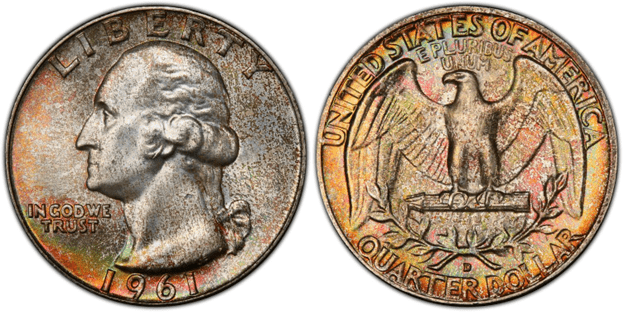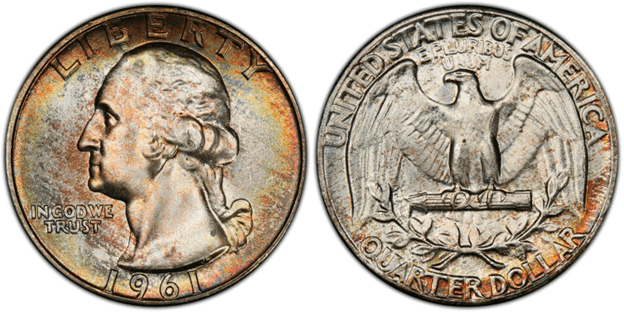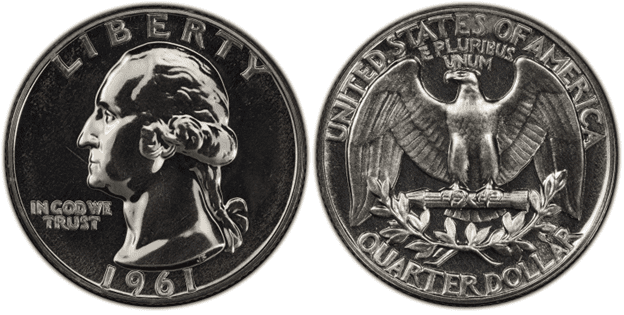What Is the 1961 Washington Quarter Made Of?
The 1961 Washington quarter is made of 90 percent silver (Ag) and 10 percent copper (Cu). Quarters made from 1932 to 1964 have the same composition. Then, in 1965, the US Mint started to produce quarter coins with base metals.
One reason is that some people would rather keep the coin than spend it. Since it’s made of silver, it would eventually increase in value. So, people thought keeping the coin would be better than spending it.
Aside from that, silver was getting more expensive. To reduce the production cost and encourage the public to spend the coin, the US Mint decided to change the composition to what it is today. As this might be the case, the US Mint still produced silver quarters starting in 1976. Only this time, the silver quarters are for collectors and not for circulation.
The Washington quarter was first struck in 1932. However, the quarter has already been in circulation since it was first issued in 1796.
The original design used in 1932 essentially remained the same in 1961. Here are the specifications of the 1961 Washington quarter:
- Value – $0.25
- Mass – 6.30 grams
- Diameter – 24.30 mm
- Thickness – 1.75 mm
- Reeded edge (119 reeds)
The year 1932 was the bicentennial of Washington’s birth. As a way to celebrate his natal day, the US Mint honored him by adding his face to the quarter coin.
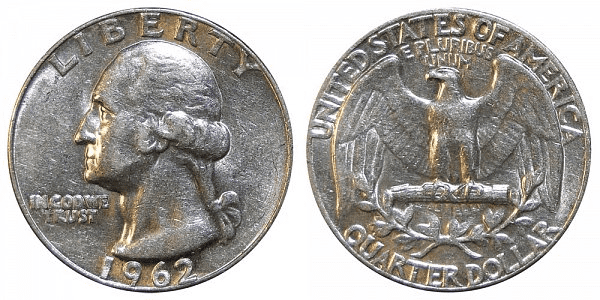
John Flanagan designed the original version of the Washington quarter. On the obverse, you’ll find the image of George Washington, the first president of the United States. The inscriptions include the following:
- LIBERTY
- IN GOD WE TRUST
- 1961
- Mint mark (if present)
On the reverse side, the heraldic eagle is holding on its talon a bundle of arrows, which signifies the readiness of the United States to defend itself. Below the eagle are olive branches, which signify peace and harmony.
The inscriptions include the following:
- UNITED STATES OF AMERICA
- E PLURIBUS UNUM (US motto, which means “Out of many, one.”)
- QUARTER DOLLAR
1961 Washington Quarter Varieties
For the 1961 Washington quarter, there are three standard-struck varieties produced. These are the 1961 D, 1961 P with no mint mark, and the 1961 P proof Washington quarter.
Aside from that, there are also those coins with errors that created a new variety.
Here are the 1961 Washington quarter varieties that you should know:
1961 D Washington Quarter
Year of minting: 1961
Mint Mark: D
Place of minting: Denver
Quantity produced: 83,656,928
Face Value: $0.25 (twenty-five cent)
Price: $7 to $24 (or more)
Mass: 6.30 grams
Edge: Reeded
Designer: John Flanagan
Composition: 90% silver and 10% copper
Diameter: 24.3 millimeters
Thickness: 1.75 millimeters

photo source: PCGS
The 1961 D Washington quarter was struck in the Denver Mint. Among the three varieties of the 1961 quarter coins, the 1961 D quarter was the most abundant, with a mintage of more than 80 million.
The price starts at around $7 to $15. It can be higher depending on the condition of the coin. For example, 1961-D, with a grade of at least MS-66, is considered rare, making its price reach five figures.
1961 P Washington Quarter
Year of minting: 1961
Mint Mark: No mint mark
Place of minting: Philadelphia
Quantity produced: 37,036,000
Face Value: $0.25 (twenty-five cent)
Price: $7 to $21 (or more)
Mass: 6.30 grams
Edge: Reeded
Designer: John Flanagan
Composition: 90% silver and 10% copper
Diameter: 24.3 millimeters
Thickness: 1.75 millimeters

photo source: PCGS
The 1961-P quarter coin was made in the Philadelphia Mint. At the end of 1961, there were 37,036,000 P Washington quarter coins produced, which was far less than what the Denver Mint produced.
The price tag of 1961-P quarter coins may start from $7 and reaches up to $21. If your 1961-P quarter receives a grade of MS-65 and higher, then its value can easily reach to hundreds or thousands of dollars.
1961 P Proof Washington Quarter
Year of minting: 1961
Mint Mark: No mint mark
Place of minting: Philadelphia
Quantity produced: 3,028,244
Face Value: $0.25 (twenty-five cent)
Price: $8 to $70 (or more)
Mass: 6.30 grams
Edge: Reeded
Designer: John Flanagan
Composition: 90% silver and 10% copper
Diameter: 24.3 millimeters
Thickness: 1.75 millimeters

photo source: PCGS
The Philadelphia Mint also produced quarter proof coins in 1961. There were about 3 million of these coins that were produced, which is far fewer than what was produced in the Denver and Philadelphia Mint. Of course, this is understandable as proof coins are meant for collectors and not for circulation.
Proof coins are more detailed, shinier, and attractive than regular-struck coins. Proof coins are even struck twice to bring out a greater detail on their surface. The average price may range from $8 to $70, which is higher than the average price of 1961-D and 1961-P quarter coins.
List of 1961 Washington Quarter Errors
With more than 123 million 1961 Washington quarter coins produced, it is not surprising to see that some of these coins had inevitably received an error. Minting errors do happen sporadically, and when they do, it can be because of several reasons, which can be any of the following:
- Deterioration of minting equipment
- Malfunctioning of minting equipment
- Human intervention
Today, due to modern minting technology, coin errors are quite rare, and when these coins do get an error, the value can be very big for coin collectors and numismatists.
Error coins are more common in the past than today. So, it is more likely that you will find 1961 error coins.
Here’s an example of a 1961 quarter coin error:
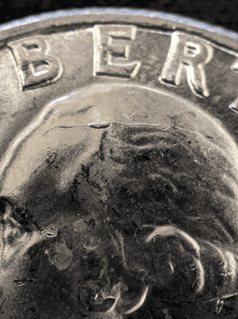
In this coin error, you’ll see a die crack on the scalp of Washington. This is known as a die break error, where the die breaks and the crack leaves its mark on the coin.
Here’s another example of a 1961 quarter coin error:
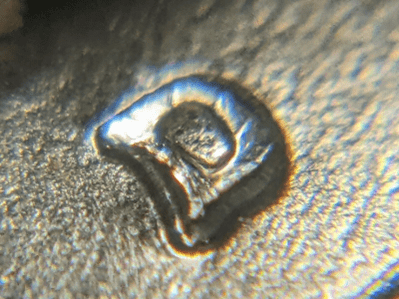
This error is called a repunched mint mark or simply RPM. Mint marks are supposed to be struck once on the coin. However, this coin was struck twice with the mint die. As a result, the mint die has a doubling in appearance.
There are also instances when the die struck the whole coin twice. So, you’ll see doubling in various engraved elements.
Sometimes, the die strikes the planchet at the wrong angle. So, the engraved materials are off-center. When the coin isn’t held properly, the die strikes it and flattens, leading to a broadstrike error.
The planchets needed to be cut before they were run into the minting process. Sometimes, there’s also a planchet error where the planchet is clipped or folded.
As you can see, there were different minting errors in 1961 for the quarter coins. Though that might sound negative, a lot of coin collectors actually like error coins because of their uniqueness and rarity.
How Much Is the 1961 Washington Quarter Worth Today?
The 1961 Washington quarter is worth $0.25, which is equivalent to its face value. It has a higher melt value since it’s made of silver. The melt value of $3.8864.
As you can see, the melt value and face value are both low. However, you can be surprised to know that the 1961 quarters are worth more than that.
Here’s a 1961 Washington Quarter values chart to help you see the value of the quarter coin:
| Coin | Condition | Grade | Mintage | Value |
| 1961 D Washington Quarter | Circulated/mint | Not graded | 83,656,928 | $7 to $24 |
| 1961 D Washington Quarter | Uncirculated/mint | MS-65 | 83,656,928 | $15 to $131 |
| 1961 D Washington Quarter | Uncirculated/mint | MS-66 | 83,656,928 | $53 to $188 |
| 1961 D Washington Quarter | Uncirculated/mint | MS-67 | 83,656,928 | $900 to $4,560 |
| 1961 P Washington Quarter | Circulated/mint | Not graded | 37,036,000 | $7 to $21 |
| 1961 P Washington Quarter | Uncirculated/mint | MS-65 | 37,036,000 | $10 to $326 |
| 1961 P Washington Quarter | Uncirculated/mint | MS-66 | 37,036,000 | $12 to $764 |
| 1961 P Washington Quarter | Uncirculated/mint | MS-67 | 37,036,000 | $240 to $2,640 |
| 1961 P Proof Washington Quarter | Uncirculated/mint | Not graded | 3,028,244 | $8 to $70 |
| 1961 P Proof Washington Quarter | Uncirculated/mint | MS-68 | 3,028,244 | $11 to $30 |
| 1961 P Proof Washington Quarter | Uncirculated/mint | MS-69 | 3,028,244 | $19 to $42 |
| 1961 P Proof Washington Quarter | Uncirculated/mint | MS-70 | 3,028,244 | $200 to $414 |
As you can see, 1961 quarter coins are more valuable than their face value. Just to give you an idea, according to PCGS, their auction record for the 1961 D quarter coin is $24,000. It was a quarter coin with a grade of MS67+, sold in a Stack’s Bowers auction in August 2019.
For the 1961-P quarter, the auction record is $9,775. Finally, for the 1961-P proof quarter, the highest auction bid was $798.
How Does The Grading System Work?
The Sheldon Scale is used by numismatists to provide a numerical value to coins. The Sheldon Scale goes from poor (P-1) to perfect mint state (P-1) (MS-70). Coins were originally evaluated using words to reflect their condition (Good, Fair, Excellent, Etc.). Unfortunately, coin collectors and dealers had different ideas about what each of these terms represent.
Professional numismatists joined together in the 1970s and established CoinGrading standards. These numismatists now assign grades at key places on the seventy-point scale, using the most regularly utilized numeric points in conjunction with the original adjective grade. The following are the most common coin grades:
-
-
- (P-1) Poor – Indistinguishable and probably damaged; if used, must have a date and mintmark; otherwise, rather battered.
- (FR-2) Fair – Nearly smooth, but without the damage that a coin graded Poor often possesses. The coin must have enough detail to be identified.
- (G-4) Fair – Inscriptions have merged into the rims in some areas, and important elements have been mostly erased.
- (VG-8) Very Good- A little weathered, but all of the primary design elements are visible, albeit faintly. There is little if any, central detail left.
- (F-12) Good – The item is very worn, yet the wear is even, and the overall design details stand out clearly. Rims are almost completely isolated from the field.
- (VF-20) Very Fine – Moderately weathered, with some finer features still visible. The motto or all letters of LIBERTY are readable. Both sides of the coin have entire rims that are separated from the field.
- (EF-40) Extremely Fine – Gently used; all gadgets are visible, and the most important ones are bold. The finer details are bold and clear, however, light wear may be seen.
- (AU-50) Uncirculated – Slight evidence of wear on the coin’s design’s high points; may have contact marks; eye appeal should be adequate.
- (AU-58) Uncirculated Choice – Slight traces of wear, no severe contact marks, almost full mint shine, and great eye appeal.
- (MS-60) Mint State Basal – Strictly uncirculated; no indication of wear on the coin’s highest points, but an unsightly coin with reduced luster, visible contact marks, hairlines, and other flaws.
- (MS-63) Mint State Acceptable – Uncirculated, but with contact scratches and nicks, little reduced shine, but otherwise appealing appearance. The strike is weak to average.
- (MS-65) Mint State Choice – Uncirculated with great mint shine, very little contact blemishes, and exceptional eye appeal. The strike is unusually severe.
- (MS-68) Mint State Premium Quality – Uncirculated with superb luster, no obvious contact marks to the naked eye, and exceptional eye appeal. The strike is quick and appealing.
- (MS-69) Almost Perfect Mint State – Uncirculated with perfect brilliance, a sharp and appealing strike, and extremely good eye appeal. A near-perfect coin with minor imperfections in the planchet, strike, and contact markings (seen only under 8x magnification).
- (MS-70) Mint State Perfect – Under 8x magnification, there are no tiny imperfections discernible; the strike is crisp, and the coin is perfectly centered on a beautiful planchet. Rarely seen on a coin, this coin is bright and whole, with original luster and exceptional eye appeal.
-
Where To Buy Or Sell 1961 Washington Quarter?
There are different places where you can buy or sell 1961 Washington quarters. For example, you can do a Google search on the Internet and use the phrase “Buy 1961 Washington quarter” or “Sell 1961 Washington quarter.” You should then receive hundreds of helpful links.
Of course, you can directly visit online selling platforms such as Amazon, eBay, and Etsy. These websites are known to be great places to find old coins. All you need to do is create an account, and you’re good to go. You can both sell and buy on these platforms.
Aside from the Internet, you can visit coin shops and antique stores. Auction houses are also known to sell beautiful, rare, and expensive coins.
FAQs
How much silver does a 1961 quarter have?
The 1961 quarter has 90% silver content. The rest is made of 10% copper.
Is the 1961 uncirculated quarter more valuable than the circulated quarter?
Generally speaking, the 1961 uncirculated quarter is more valuable than the circulated quarter. Uncirculated quarters tend to have a good preservation level, unlike circulated quarters that have gone through a lot of usages.
Is there anything special about the 1961 quarter?
A 1961 quarter becomes special when it has a great level of preservation. Once it is professionally graded and received a grade of at least MS 66, it can be very valuable.

